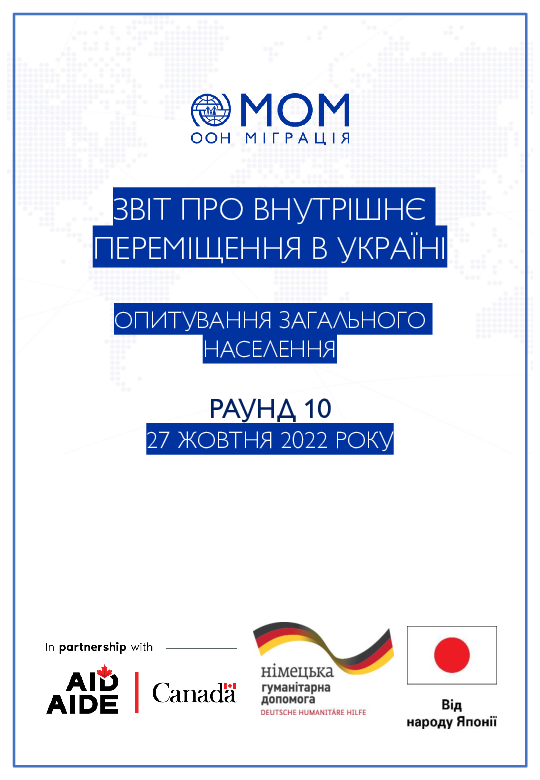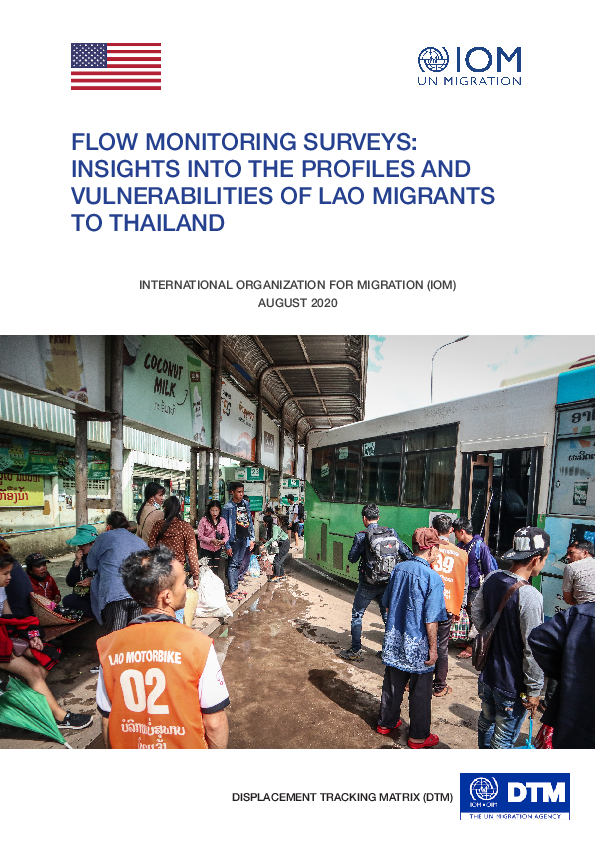-
Countries
-
Data and Analysis
-
Special Focus
-
Crisis Responses

Contact
DTMMozambique@iom.int
Language
English
Location
Mozambique
Period Covered
Nov 09 2022
Nov 13 2022
Activity
- Mobility Tracking
- Event Tracking
Fear of attacks and confirmed attacks by Non-State Armed Groups in Namuno district from 9 November triggered 10,091 individual displacement movements within and between neighbouring districts of Namuno. DTM monitoring teams recorded at least 5 major travel routes taken by populations on the move between 09-13 November. This includes movements within Namuno (4,484 individuals), movements from Namuno to Montepuez (1,225 individuals), movements from Balama to Montepuez (3,352 individuals), movements within Balama (992 individuals) and movements from Namuno to Balama (38 individuals). An estimate of 691 Internally Displaced Persons (IDPs) have been identified with vulnerabilities. Of the 10,091 individual displacement movements recorded, an estimate 4,722 Individuals (of which 2,657 represent children under 18 years old) walked to their current location of displacement. Within this reporting period, 90 per cent of the recorded movements represent individuals displaced for the first time and 10 per cent for the second time.
IOM teams observed an average of 2,018 individuals arriving at different locations within the reporting period (09 - 12 November, please see below for more information). Movements in the region continue to be dynamic between host communities. Cumulatively, from the first attacks in Namuno on 29 October to date, an estimated 16,479 first time individual displacements have been observed by DTM monitoring teams. The objective of the Emergency Tracking Tool (ETT) - Movement Alert is to collect information on large and sudden population movements, and to provide support to the humanitarian response partners by disseminating data on IDPs to support effective humanitarian response to the affected population. Information is collected through key informants interviews or direct observation. This dashboard provides basic information on displacements, and additional information can be shared upon request.

Contact
DTMUkraine@iom.int
Language
Ukrainian
Location
Ukraine
Period Covered
Oct 17 2022
Oct 27 2022
Activity
- Survey
Bійна в Україні, яка розпочалася 24 лютого 2022 року, спричинила безпрецедентну гуманітарну кризу, що охопила всі області країни. У період з 17 по 27 жовтня Міжнародна організація з міграції (MOM) провела десятий раунд репрезентативного експрес оцінювання загального населення України для збору інформації стосовно потоків внутрішнього переміщення та мобільності, а також для оцінювання місцевих потреб. Це оцінювання загального населення слугує первинним джерелом для виявлення сфер із високими гуманітарними потребами та визначення цільових заходів реагування для надання допомоги населенню, що постраждало від війни. Географічне охоплення цього оцінювання покриває всю територію України, усі п’ять макрорегіонів (схід, північ, центр, південь та місто Київ), за винятком Кримського півострова.
Опитування загального населення проведено шляхом набору випадкових телефонних номерів, завдяки чому було анонімно опитано 2 002 унікальних респондентів віком від 18 років із використанням методу автоматизованого телефонного опитування (CATI). Оцінка спирається на дані про населення Фонду народонаселення ООН (UNFPA), які гуманітарна спільнота розглядає як базове значення для чисельності населення в Україні. Особи, які нині перебувають за межами України, під опитування не потрапили. Докладніше про метод і обмеження, у тому числі про визначення МОМ терміну «внутрішньо переміщені особи» для цілей цього оцінювання, див на с. 12. Крім Опитування загального населення, офіційні дані про присутність ВПО на рівні громад в Україні доступні в Матриці відстеження переміщень Базовому оцінюванні (раунд 14 – 16 жовтня 2022 року, HDX реєстрація обов’язкова).

Contact
Michelle Münstermann, DTM Thailand Coordinator, mmunstermann@iom.int
Language
English
Location
Laos
Period Covered
Jul 15 2019
Aug 15 2019
Activity
- Survey
- Flow Monitoring Survey
- Flow Monitoring
In order to gain a better understanding of the migration patterns and the nature of flows from Lao People’s Democratic Republic to Thailand – with a particular focus on possible vulnerabilities – IOM initiated a survey exercise in July 2019 in Vientiane Capital, utilizing the Flow Monitoring component of IOM’s Displacement Tracking Matrix (DTM). Flow Monitoring is a tool designed to track movement flows, and the overall situation at key points of origin, transit and destination. It is an optimal tool to provide a more detailed understanding of the migration situation at the Thai-Lao border. With special consideration to the experience of migrant workers, IOM aimed to gain a deeper understanding of migrants’ profiles, drivers of migration, level of preparedness for migration, as well as associated vulnerabilities and return intentions. This research activity was part of a larger regional activity that collected DTM data across various countries in Southeast Asia. It built upon the pre-established Flow Monitoring Registry and Flow Monitoring Survey activities along the Thai-Myanmar border in Tak province, Thailand, from June 2018 until May 2019 as well as the Flow Monitoring activities along the Thai-Cambodia border, from March 2019 until September 2019.

Contact
DTM Yemen, DTMYemen@iom.int
Language
English
Location
Yemen
Period Covered
Sep 07 2022
Sep 30 2022
Activity
- Site Assessment
IOM DTM conducted an intention survey in 22 displacement sites in Ma’rib City District and one site in Ma’rib District of Ma’rib Governorate between 7 and 30 September 2022. Two days after the data collection the truce that had been in place since 2 April 2022 broke. However, despite half a year of truce, IOM encountered very few households that intended to leave the assessed displacement sites. There are a total of 61 displacement sites in Marib City District and 198 in Ma’rib Governorate as a whole according to the Yemen Camp Coordination and Camp Management Cluster.
The sample of 2,227 interviewed households represents 11 per cent of the assessed sites total in household population numbers (21,014 HHs) with 14,784 individuals in the assessed households, the average household size was 6.6 individuals.
Site population sizes average around 450 households per assessed site with the exception of Al Jufainah, which currently houses 11,200 families. DTM assessed an average of 12 per cent of each site’s population with a minimum of 40 households, the largest being Al Jufainah where DTM interviewed 1,126 households.
IOM DTM tracks new instances of displacement through the Rapid Displacement Tracking tool in 13 southern governorates under the control of the Internationally Recognized Government. Within this scope, the highest number of newly displaced households per governorate between January and September 2022 was found in Ma’rib. IOM tracked 8,975 new instances of displacement (households) within these nine months of which 2,350 households (26%) fled to or within Ma’rib, followed by Al Hodeidah (1,983 HHs, 22%) and Shabwah (1,448 HHs, 16%).

Contact
DTM Cameroun, DTMCameroon@iom.int
Language
French
Location
Cameroon
Period Covered
Aug 01 2022
Aug 31 2022
Activity
- Mobility Tracking
- Site Assessment
Depuis 2014, le Cameroun est l’objet d’attaques perpétrées par des groupes armés. Les attaques et les menaces récurrentes continuent de provoquer des déplacements de populations vivant dans la région de l’Extrême-Nord. Du fait de sa situation géographique et culturelle, et notamment sa proximité avec le Nigéria et le Tchad, la région a subi des dégâts matériels et humains importants.
En réponse, l’Organisation Internationale pour les Migrations (OIM) déploie, depuis novembre 2015, la Matrice de suivi des déplacements (Displacement Tracking Matrix- DTM, en anglais), un outil qui collecte des données sur les tendances de déplacement ainsi que les besoins humanitaires multisectoriels des personnes affectées par les crises. Ces informations sont analysées et partagées avec la communauté humanitaire afin d’orienter les programmes de réponse ou des évaluations sectorielles plus approfondies.
Ce tableau de bord présente un brief aperçu de la situation de déplacement ainsi que les besoins humanitaires.
La collecte de données a été conduite du 11 au 24 août 2022 dans 1191 localités (1092) et site spontanés (99) accueillant des personnes déplacées internes, retournées et réfugiées hors camp dans les 6 départements de la région de l’Extrême Nord auprès de 4 298 informateurs, par 132 enquêteurs qui ont été formés sur la méthodologie de la DTM et MSNA par les chefs de file des secteurs et l’équipe OIM. La collecte s’est faite auprès des informateurs clés (chefs de village, leaders communautaires, représentants des déplacés, acteurs humanitaires, acteurs étatiques, autorités administratives etc.) dans les localités accueillant les populations déplacées depuis le dernier rapport de suivi des déplacements et les alertes sur les mouvements de populations avant cette collecte.
Suite à la collecte des données suivant un questionnaire élaboré par l’OIM, OCHA et les différents secteurs, l’aperçu des besoins a été obtenu à la suite des analyses des données conjointes faite avec les chefs de file de chaque secteur
Contact
dtmlibya@iom.int
Location
Libya
Activity
- Mobility Tracking
- Baseline Assessment
Period Covered
Jul 01 2022 -Aug 31 2022
A baseline assessment is a sub-component of mobility tracking. It aims to collect data on IDP, migrant or returnee population presence in a defined administrative area of the country.
Population Groups
Survey Methodology
Unit of Analysis Or Observation
Type of Survey or Assessment
Keywords
Geographical Scope
Administrative boundaries with available data
The current dataset covers the following administrative boundaries

Contact
DTM Libya, DTMLibya@iom.int
Language
English
Location
Libya
Period Covered
Jul 01 2022
Aug 31 2022
Activity
- Flow Monitoring
- Mobility Tracking
- Baseline Assessment
This infographic presents the key findings of Round 43 of the mobility tracking component of the Displacement Tracking Matrix (DTM) programme in Libya.

Contact
DTM Libya, DTMLibya@iom.int
Language
English
Location
Libya
Period Covered
Jul 01 2022
Aug 31 2022
Activity
- Mobility Tracking
- Baseline Assessment
IOM Libya’s Displacement Tracking Matrix (DTM) programme identified a total of 679,974 migrants from over 41 nationalities in the 100 Libyan municipalities during Round 43 of data collection (July - August 2022).
The number of migrants in Libya has continued to increase slightly compared to the previous reporting period (667,440 migrants, Round 42, June 2022) in line with a trend that started at the beginning of 2021. Prior to 2021 the number of migrants in Libya had been decreasing following the outbreak of the COVID-19 pandemic in 2020. The number of migrants in Libya identified during Round 43 is also higher than the number of migrants for the corresponding period in 2019 (636,426 migrants, Round 27, September 2019).

Contact
DTMcovid19@iom.int
Language
English
Location
Global
Period Covered
Oct 31 2022
Nov 07 2022
Activity
- Other
The DTM Global Mobility Restrictions Overview provides updates on international air travel restrictions and conditions for authorized entry. This overview aims to understand how COVID-19 has impacted human mobility, detailing how global and regional trends in air travel measures have evolved since COVID-19 was declared a global pandemic in March 2020. The data presented focuses on the changes in public health-related immigration and border management measures. It provides information intended to support IOM missions and partners in targeted response planning and advocacy for vulnerable populations who may be affected by changes in global mobility.

Contact
DTM Pakistan, iomisbdtmremapteam@iom.int
Language
English
Location
Pakistan
Period Covered
Oct 22 2022
Nov 04 2022
Activity
- Flow Monitoring
IOM Pakistan collects data on the outflows of undocumented Afghan migrants at the Torkham and Chaman border crossing points in an effort to better understand the migration movements of undocumented Afghan migrants returning to Afghanistan from Pakistan. This exercise is part of the European Union funded project “Displacement Tracking Matrix Regional Evidence for Migration Analysis and Policy (DTM REMAP)”.
Between 22 October and 4 November 2022, 2,697 undocumented Afghan migrants spontaneously returned to Afghanistan, including 509 through the Torkham border point and 2,188 through the Chaman border point. Border authorities facilitated the return of 138 individuals due to the lack of legal documentation to remain in Pakistan. Therefore, information about these individuals is not included in the count. Although IOM identified 2,188 undocumented Afghan returnees at two border crossings, this may not reflect the total number of undocumented Afghan returnees. Moreover, for this study, only the head of household or representative of the family were interviewed. This means that the number of interviews conducted by the enumerators is lower than the number of returnees recorded by IOM. Between 22 ctober and 4 November 2022, IOM interviewed 191 respondents.